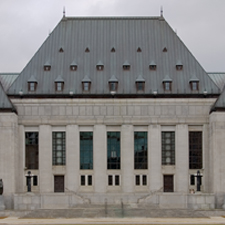OAKES TEST
Supreme Court of Canada

Any analysis as to whether a restriction of rights guaranteed by ss. 7 and 11(d) [of the Canadian Charter of Rights and Freedoms] is salvaged by s. 1 of the Charter [which provides that all Charter rights are “subject only to such reasonable limits prescribed by law as can be demonstrably justified in a free and democratic society”] involves the application of the decision of this Court in R. v. Oakes, [1986] 1 S.C.R. 103 ...
The first criterion stated in Oakes is that the objective of the measure that restricts a guaranteed right or freedom must be “of sufficient importance to warrant overriding a constitutionally protected right or freedom” [p. 138] [which involves identifying the objective of the measure and assessing whether such objective is of sufficient importance to warrant overriding the rights protected by the Charter] ...
. . . . .
The second criterion stated in Oakes requires that the means chosen to attain this objective be proportional or appropriate to these ends. A measure will be said to satisfy this criterion when it is rationally connected with the objective it is designed to achieve, when it impairs the fundamental right or freedom which it limits as little as possible, and when there is a proportionality between the effects of the measure limiting such right or freedom and the objective identified as having sufficient importance.
R. v. Penno | (westlaw Canada)
1990 CarswellOnt 1003 at para. 30-31, 34 | (Westlaw Canada)
Lamer C.J.C.
British Columbia
The seminal test with respect to [whether a measure constitutes a “reasonable limit” under] s. 1 [of the Charter] comprises principles set out in R. v. Oakes[1986] 1 S.C.R. 103...
(1) Any inquiry as to the application of s. 1 must be considered in the first instance from the point of view that an entrenched right guaranteed by the Charter is being limited, and it is a right and freedom which is a part of the supreme law of Canada.
(2) The Court must be guided by the values and principles essential to a free and democratic society, inter alia, a commitment to social justice, and although not absolute, where such rights are inimical to the realization of collective goals of fundamental importance, the section imposes a stringent standard of justification for their suspension.
(3) Although the onus is the civil onus of “probability”, different degrees of probability exist, and a very high degree of probability “commensurate with the occasion” is required. In addition, “Where the evidence is required ... and this will generally be the case, it should be cogent and persuasive and make clear to the Court the consequences of imposing or not imposing the limit” (p. 138)
(4) To establish a limit that is “demonstrably justified”, two central criteria must be satisfied:
a) The objective must relate to concerns which are pressing and substantial, and of sufficient importance to warrant overriding a constitutionally protected right or freedom; and
(b) The party showing the validity of the objective must also show that the means chosen are reasonably and demonstrably justified. This involves a “proportionality test”.
(5) In applying a “proportionality test”, the means employed must be rationally connected to the objective; they must not be arbitrary, unfair or based on irrational considerations. Second, they should impair “as little as possible” the right or freedom in question, and third, there must be a proportionality between the effects of the measures limiting the freedom infringed upon and the objective which has been identified as of “sufficient importance”.
R. v. Kumar | (westlaw Canada)
1990 CarswellBC 341 at para. 82-87 | (Westlaw Canada)
Hogarth J.